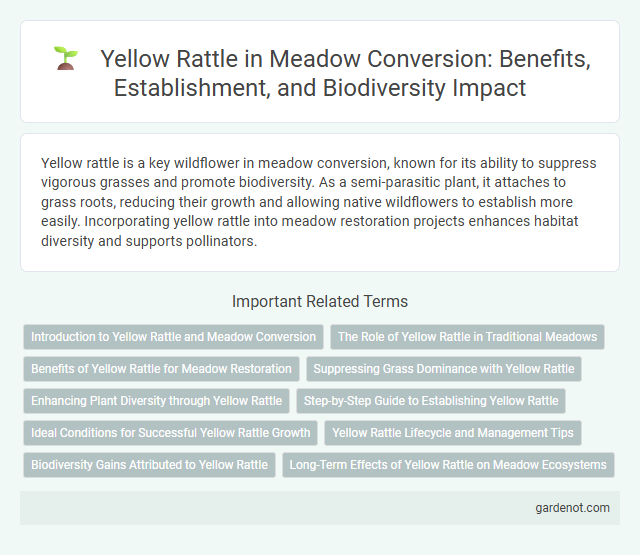Yellow rattle is a key wildflower in meadow conversion, known for its ability to suppress vigorous grasses and promote biodiversity. As a semi-parasitic plant, it attaches to grass roots, reducing their growth and allowing native wildflowers to establish more easily. Incorporating yellow rattle into meadow restoration projects enhances habitat diversity and supports pollinators.
Introduction to Yellow Rattle and Meadow Conversion
Yellow rattle (Rhinanthus minor) is a semi-parasitic wildflower that plays a crucial role in meadow conversion by suppressing aggressive grasses and promoting wildflower diversity. Introducing yellow rattle into grass-dominated fields reduces grass vigor, allowing native wildflowers to establish and flourish, which enhances overall meadow biodiversity. Its presence accelerates the transformation of improved grassland into species-rich meadows, making it a key tool in ecological restoration projects.
The Role of Yellow Rattle in Traditional Meadows
Yellow rattle (Rhinanthus minor) plays a crucial role in traditional meadows by naturally controlling vigorous grasses, allowing a diverse range of wildflowers to thrive. As a hemi-parasitic plant, it extracts nutrients from dominant grass species, reducing their competitive advantage and enhancing biodiversity. This ecological balance supports pollinators and maintains the characteristic floral variety of old meadow ecosystems.
Benefits of Yellow Rattle for Meadow Restoration
Yellow Rattle (Rhinanthus minor) is a hemiparasitic plant that naturally suppresses aggressive grasses, allowing wildflowers to flourish in meadow restoration projects. Its ability to reduce dominant grass species increases biodiversity by promoting a diverse range of native flora and supporting pollinators such as bees and butterflies. Incorporating Yellow Rattle enhances soil health and ecosystem resilience, making it a cornerstone species for successful meadow conversion and habitat revitalization.
Suppressing Grass Dominance with Yellow Rattle
Yellow rattle (Rhinanthus minor) effectively suppresses grass dominance by parasitizing the roots of vigorous grasses, reducing their growth and allowing wildflower species to thrive in meadow conversions. Its hemiparasitic nature decreases competition for nutrients and light, promoting greater biodiversity and enhancing habitat quality. Integrating yellow rattle into meadow restoration projects optimizes species richness and balance within grass-dominated ecosystems.
Enhancing Plant Diversity through Yellow Rattle
Yellow rattle (Rhinanthus minor) plays a pivotal role in enhancing plant diversity within meadow conversions by parasitizing dominant grass species, reducing their vigor and allowing wildflowers to flourish. This hemiparasitic plant naturally suppresses competitive grasses, creating space and resources for a wider range of native flora, thus increasing biodiversity. Incorporating yellow rattle in meadow restoration projects significantly improves ecological balance and supports diverse insect populations essential for pollination.
Step-by-Step Guide to Establishing Yellow Rattle
Start by selecting a suitable meadow area with well-drained soil and low fertility to encourage yellow rattle growth. Prepare the site by removing existing dense grasses and weeds through scarification or strimming to create bare soil patches. Sow yellow rattle seeds in late summer or early autumn, ensuring good soil-seed contact and water regularly to support germination and establishment.
Ideal Conditions for Successful Yellow Rattle Growth
Yellow rattle (Rhinanthus minor) thrives best in well-drained, nutrient-poor meadows with low soil fertility, which reduces grass dominance and allows wildflower diversity to flourish. It prefers full sun to partial shade and grows optimally in neutral to slightly acidic soils with a pH of 6.0 to 7.0. Maintaining regular meadow mowing or grazing prevents competitors from overshadowing yellow rattle, supporting its hemiparasitic lifestyle crucial for successful meadow conversion.
Yellow Rattle Lifecycle and Management Tips
Yellow Rattle (Rhinanthus minor) completes its lifecycle by germinating in autumn, overwintering as a seedling, and flowering between June and August. It is a hemiparasitic plant that weakens grasses, promoting biodiversity by allowing wildflowers to flourish in meadow ecosystems. To manage Yellow Rattle effectively, sow seeds in late autumn on well-prepared, low-fertility soil and monitor grass growth to prevent dominance while avoiding excessive disturbance.
Biodiversity Gains Attributed to Yellow Rattle
Yellow rattle (Rhinanthus minor) significantly enhances biodiversity in meadow conversion by suppressing dominant grasses, allowing a wider variety of wildflowers to thrive. Studies show that its presence increases plant species richness by up to 50%, creating habitats that support diverse pollinators and insects. This boost in floral diversity consequently strengthens ecosystem resilience and improves overall meadow health.
Long-Term Effects of Yellow Rattle on Meadow Ecosystems
Yellow rattle (Rhinanthus minor) exerts significant long-term effects on meadow ecosystems by reducing the dominance of aggressive grasses through its hemiparasitic nature, thereby enhancing plant biodiversity and promoting coexistence among herbaceous species. This parasitism decreases nutrient competition, allowing a wider variety of wildflowers to establish and thrive, which subsequently supports higher insect diversity and improves habitat complexity. Over extended periods, the presence of yellow rattle contributes to the restoration and maintenance of species-rich meadows, crucial for sustaining ecological balance and conservation efforts.
Yellow rattle Infographic

 gardenot.com
gardenot.com